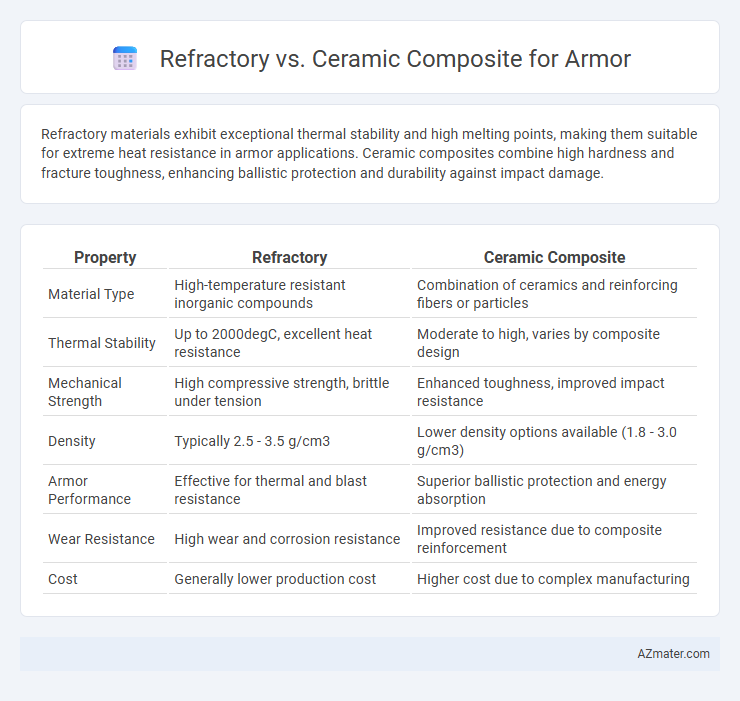Refractory materials exhibit exceptional thermal stability and high melting points, making them suitable for extreme heat resistance in armor applications. Ceramic composites combine high hardness and fracture toughness, enhancing ballistic protection and durability against impact damage.
Table of Comparison
| Property | Refractory | Ceramic Composite |
|---|---|---|
| Material Type | High-temperature resistant inorganic compounds | Combination of ceramics and reinforcing fibers or particles |
| Thermal Stability | Up to 2000degC, excellent heat resistance | Moderate to high, varies by composite design |
| Mechanical Strength | High compressive strength, brittle under tension | Enhanced toughness, improved impact resistance |
| Density | Typically 2.5 - 3.5 g/cm3 | Lower density options available (1.8 - 3.0 g/cm3) |
| Armor Performance | Effective for thermal and blast resistance | Superior ballistic protection and energy absorption |
| Wear Resistance | High wear and corrosion resistance | Improved resistance due to composite reinforcement |
| Cost | Generally lower production cost | Higher cost due to complex manufacturing |
Introduction to Armor Materials: Refractory vs. Ceramic Composites
Refractory materials for armor exhibit exceptional high-temperature stability and thermal shock resistance, making them ideal for environments with extreme heat exposure. Ceramic composites, combining brittle ceramics with ductile materials, offer enhanced fracture toughness and impact resistance, improving ballistic performance. Comparing these materials highlights the trade-offs between thermal endurance and mechanical resilience essential for advanced armor systems.
Key Properties of Refractory Materials in Armor Applications
Refractory materials in armor applications exhibit exceptional high-temperature stability, maintaining structural integrity under extreme thermal conditions caused by ballistic impacts and explosions. Their superior hardness and thermal shock resistance enhance protective capabilities against high-velocity projectiles and incendiary threats. Compared to ceramic composites, refractory materials often provide improved wear resistance and durability, essential for sustained armor performance in harsh environments.
Advantages of Ceramic Composites for Protective Armor
Ceramic composites offer superior hardness and high compressive strength, enhancing ballistic resistance while minimizing weight for protective armor applications. Their ability to dissipate impact energy efficiently reduces penetration and spall, providing improved multi-hit performance compared to traditional refractory materials. Advanced ceramic composites also exhibit better thermal stability and corrosion resistance, extending armor durability in harsh environments.
Comparative Ballistic Performance: Refractory vs. Ceramic Composite
Refractory materials offer high thermal stability and superior resistance to high-velocity impacts, making them effective in ballistic armor applications by maintaining integrity under extreme heat and mechanical stress. Ceramic composites, composed of hard ceramic particles combined with ductile matrices, provide enhanced toughness and energy absorption, resulting in improved multi-hit ballistic performance compared to monolithic refractory armor. Comparative ballistic assessments reveal that ceramic composites deliver better crack arrest capabilities and weight efficiency, while refractories excel in thermal resilience and durability against sustained ballistic exposure.
Weight and Structural Considerations in Armor Design
Refractory materials in armor offer high-temperature resistance and structural stability but tend to be denser, increasing overall weight compared to ceramic composites. Ceramic composites combine lightweight properties with excellent hardness, enhancing ballistic performance while reducing load on the wearer or vehicle. Structural considerations emphasize balancing weight reduction with sufficient impact resistance, where ceramic composites provide superior fracture toughness and energy dispersion, improving armor design efficiency.
Thermal Resistance and Stability Factors
Refractory materials exhibit exceptional thermal resistance with melting points often exceeding 2000degC, making them highly stable under extreme heat conditions encountered in armor applications. Ceramic composites combine high hardness with enhanced fracture toughness, maintaining structural integrity and thermal stability at temperatures typically up to 1600degC. The superior thermal shock resistance and low thermal conductivity of advanced ceramic composites further optimize armor performance by minimizing heat transfer and preventing material degradation during high-velocity impacts.
Cost-efficiency of Refractory and Ceramic Composite Armors
Refractory armor materials, such as tungsten and tantalum alloys, offer high thermal resistance and durability but come with higher raw material and manufacturing costs compared to ceramic composites. Ceramic composite armors, typically made from alumina, silicon carbide, or boron carbide combined with fiber-reinforced matrices, provide a more cost-efficient solution due to lower material expenses and scalable production processes while maintaining effective ballistic protection. Evaluating total lifecycle costs, ceramic composites generally deliver better cost-efficiency by balancing performance, weight, and affordability in large-scale armor applications.
Durability and Longevity in Field Conditions
Refractory materials in armor systems offer superior thermal stability and resistance to high-temperature impacts, enhancing durability under extreme conditions, while ceramic composites provide exceptional hardness and fracture toughness, improving longevity against ballistic threats. Ceramic composites often incorporate alumina, silicon carbide, or boron carbide, delivering lightweight protection with efficient energy absorption, whereas refractory materials excel in maintaining structural integrity during prolonged exposure to heat and mechanical stress. Field performance data indicates ceramic composites sustain multiple impacts with minimal degradation, whereas refractory armor showcases extended lifespan in high-heat environments, making each suitable for specialized operational demands.
Recent Innovations in Armor Material Science
Recent innovations in armor material science highlight the enhanced ballistic performance of refractory metals like tungsten and molybdenum when combined with ceramic composites such as silicon carbide and alumina. The integration of refractory metals improves thermal stability and impact resistance, while ceramic composites offer lightweight protection and superior hardness, resulting in armor systems with optimized durability and reduced weight. Advanced manufacturing techniques like additive manufacturing and nano-engineering enable precise microstructural control, further enhancing the synergy between refractory and ceramic materials for next-generation ballistic armor.
Future Trends in High-performance Armor Material Development
Refractory materials, known for exceptional thermal stability and hardness, are increasingly integrated with ceramic composites to enhance ballistic resistance and multi-hit performance in armor systems. Future trends emphasize nano-engineered ceramic phases combined with refractory matrices to achieve superior strength-to-weight ratios and improved energy absorption under high-velocity impacts. Advancements in additive manufacturing and hybrid composite architectures enable tailored microstructures, driving the development of next-generation lightweight, durable armor solutions for military and aerospace applications.

Infographic: Refractory vs Ceramic composite for Armor
 azmater.com
azmater.com